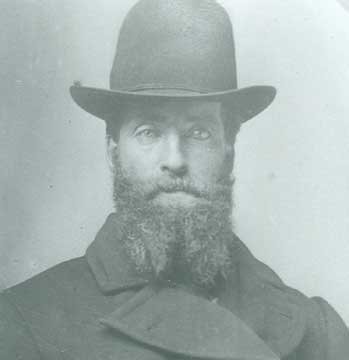In the early days of the Key Peninsula, doctors and hospitals were some distance away, and only reachable by boat.
The Native Americans who camped and later lived in the area offered various plants for medications, and the early settlers brought their own homemade remedies with them. Families doctored themselves, or neighbors helped neighbors, and certain women in the communities became midwives.
 John Alexander Hall, first practicing doctor in Vaughn, 1889-1895. Photo courtesy KP Historical Society Museum
John Alexander Hall, first practicing doctor in Vaughn, 1889-1895. Photo courtesy KP Historical Society Museum
Marge Radonich says her dad and brothers formed their own logging company in part because of how injuries in the woods were treated. An injured man was propped up by a stump until the workday was over, then transported back to camp on a wagon. Some didn’t survive.
Many local “old-timers” have stories of traveling to doctors and hospitals or bringing in medical help on the early boats.
Two early doctors on the peninsula both arrived in Vaughn. Dr. Joseph Coblentz, a physician in Illinois in 1888, was nearly 69 when he came to Vaughn with his son and family from Kansas. He never practiced in the community, as far as local historians can determine.
John Alexander Hall, from Missouri by way of Texas and California, in late 1889. His dream was to farm. At age 52, he did some minor practicing in Vaughn, but his wife thought the community too small for major practice; people knew each other too well. Great-granddaughter Dulcie Schillinger says, “Cornelia would not allow him to deliver babies.” Local midwife “Grandma” Wright continued with that service.
Hall maintained good physical health, chopped wood every morning, after a quick swim in the bay, regardless of weather or time of year.
He was killed by a falling tree while in the process of clearing his land in 1895. J. A. Hall Road in Vaughn was named for him.
Dr. J. J. Leisir had an office near the dock in Home, with a pharmacy in back, from 1919 to 1928. He delivered Evelyn Dadisman Evans, among other local babies. He backed his Model T off the bay road below his house once, and needed rescuing. Evans says he was an elderly man. He died in 1928.
Dr. G. A. T. De l’Espinnase worked with Dr. Leisir in Home for awhile. His assessed property value in the 1915 Pierce County directory was $120.
“Doc” Lawrence’s office was near the Cooper Hotel in Lakebay, about 1930. He apparently operated “outside the realm,” according to local scuttlebutt, with a questionable reputation or credentials. However, many local residents were his patients. He may have been the doctor who was known to never bill patients, accepting groceries, and even a suit of clothes as payment.
Dr. Arthur Seeley Monzingo operated a small hospital in Gig Harbor from 1925 to 1943. Marguerite Bussard said he came to her Longbranch home to deliver her.
Dr. Merrill E. Thomas, an osteopath, lived in Glencove, but had an office in Home in the early 1930s. He treated animals and once removed the scent glands from a skunk, which he delighted in releasing at the Sportsmen’s Club. Thomas was active in several local organizations, and helped establish the Sportsmen’s Club, Evergreen School, and Penrose Park. Dale Ramsdell was one of his deliveries. Thomas Road in Glencove was named for him. Key Pen’s Dr. William Roes has a bookcase, some medical equipment and artifacts that belonged to Thomas, who died in 1962 in an Allyn nursing home.
Dwayne Johnson’s office was in a large white building next to the Lakebay marina. Some old-timers called it a clinic, and several local residents were born there, including Nick Boquist. Johnson practiced from 1930 to 1935. He doctored Chet Dadisman, quarantined with scarlet fever for six weeks, and also made home visits to Dadisman’s grandfather Lehman in his last years. Lottie Dadisman had a fingertip amputated by Johnson, and it grew back, says daughter Evelyn Evans.
Johnson’s son, playmate of Henry Ramsdell, received a red wagon for Christmas, and the boys enjoyed using it. Ramsdell tells about falling on an axe when he was 5 or 6, and Dr. Johnson stitched it up. While Ramsdell was “out” with the ether, the doctor also performed an additional delayed surgery.
Other doctors lived or visited the peninsula in later years, including David Glenn of Rocky Bay, R. G. Gilbert of Burley, and Kyle Chapman, who saw a few local patients at his home after retiring on the Key Pen.
In 1972, Jeanne Broadsack, public health nurse practitioner, brought supplies from Tacoma for a clinic in a building on the grounds of Longbranch Church. Judy Wilson and Nat Knox, retired Navy nurses, helped. Donated clothes grew into the Angel Guild, which donated money to the health clinic.
In 1981, Roes put in half-day each week at the clinic, under a three-year obligation with the National Health Service Corps. He became full time in 1984, and the rest of the story is doctors, nurse practitioners, and an up-to-date facility on the Key Peninsula.
This article is based on local interviews, museum histories, and research by Dr. William Roes.
UNDERWRITTEN BY THE FUND FOR NONPROFIT NEWS (NEWSMATCH) AT THE MIAMI FOUNDATION, THE ANGEL GUILD, ADVERTISERS, DONORS AND PEOPLE WHO SUPPORT INDEPENDENT, NONPROFIT LOCAL NEWS